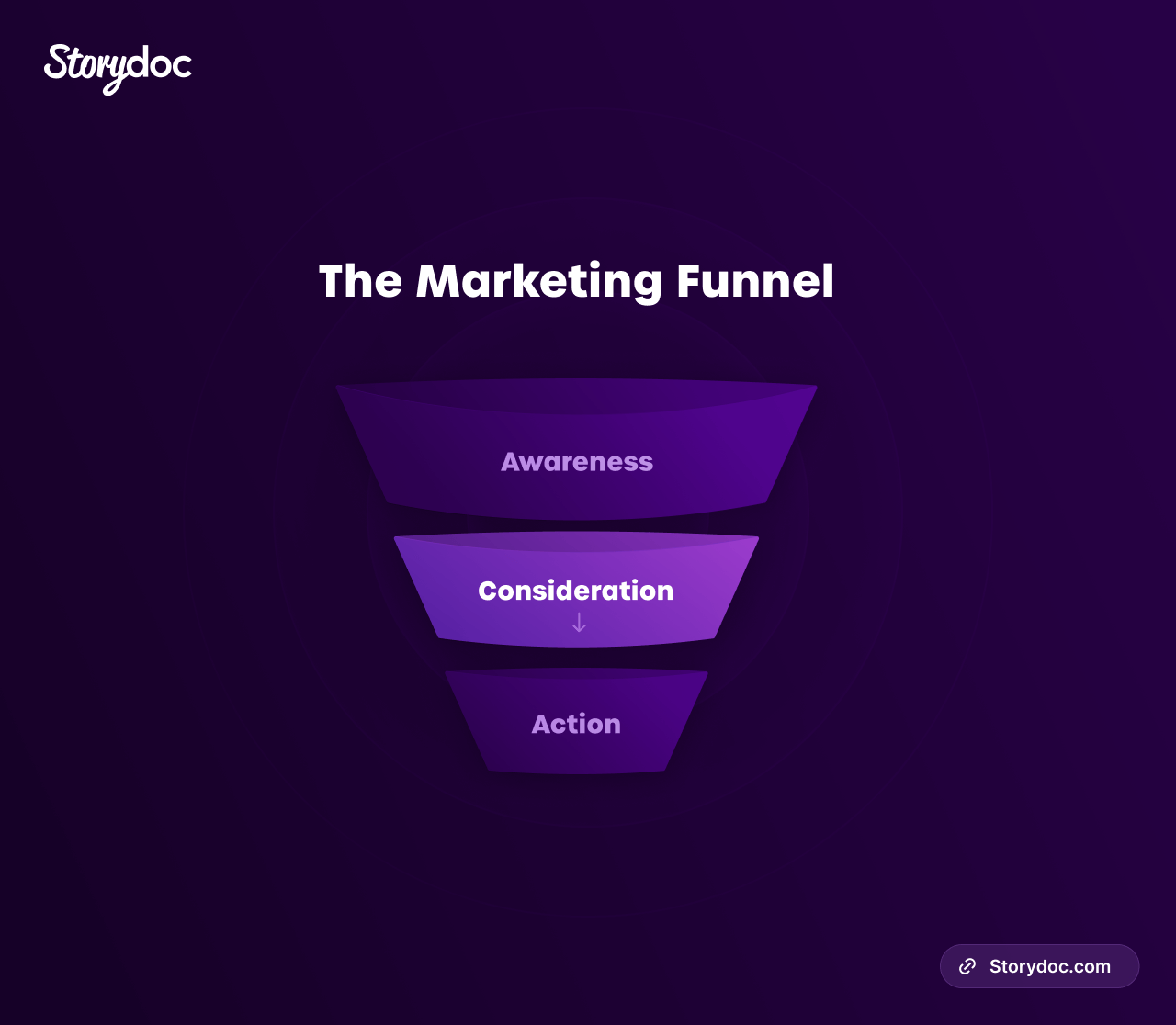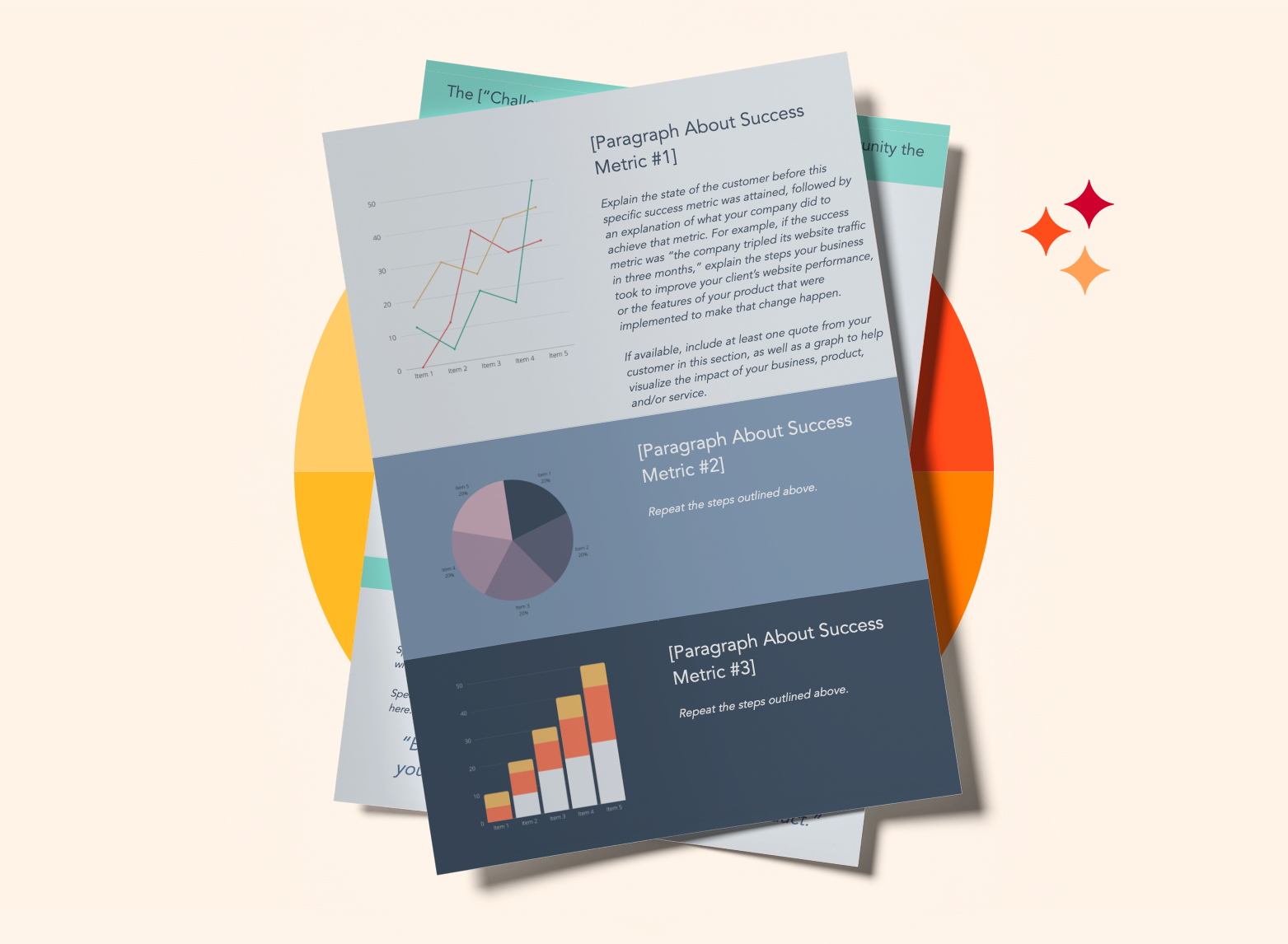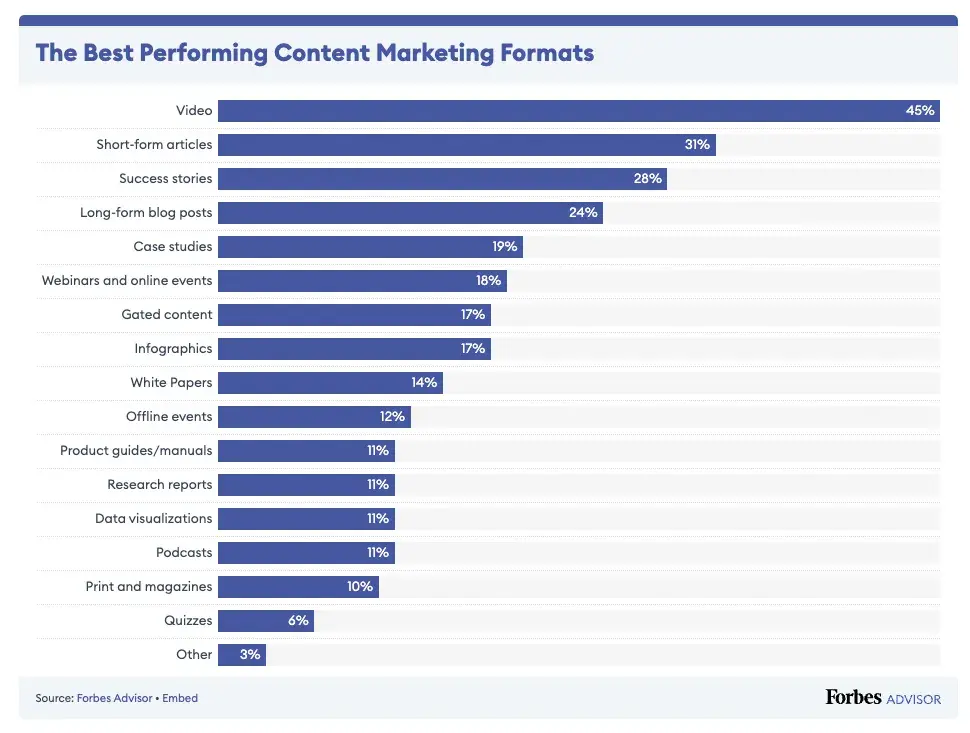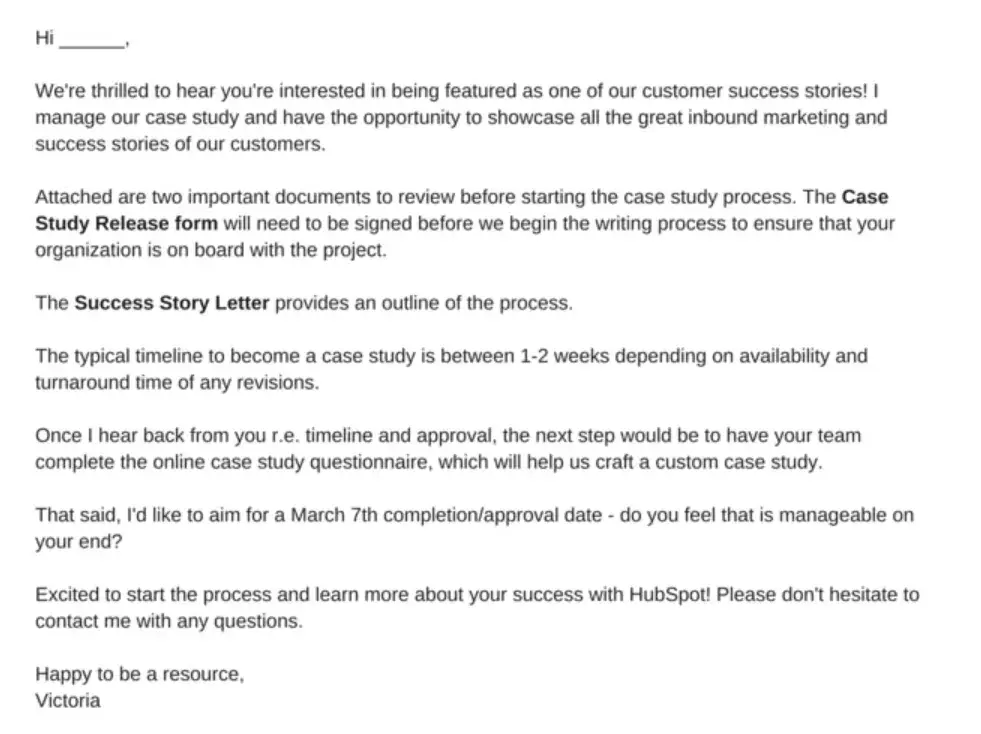How to write a case study — examples, templates, and tools

It’s a marketer’s job to communicate the effectiveness of a product or service to potential and current customers to convince them to buy and keep business moving. One of the best methods for doing this is to share success stories that are relatable to prospects and customers based on their pain points, experiences, and overall needs.
That’s where case studies come in. Case studies are an essential part of a content marketing plan. These in-depth stories of customer experiences are some of the most effective at demonstrating the value of a product or service. Yet many marketers don’t use them, whether because of their regimented formats or the process of customer involvement and approval.
A case study is a powerful tool for showcasing your hard work and the success your customer achieved. But writing a great case study can be difficult if you’ve never done it before or if it’s been a while. This guide will show you how to write an effective case study and provide real-world examples and templates that will keep readers engaged and support your business.
In this article, you’ll learn:

What is a case study?
How to write a case study, case study templates, case study examples, case study tools.
A case study is the detailed story of a customer’s experience with a product or service that demonstrates their success and often includes measurable outcomes. Case studies are used in a range of fields and for various reasons, from business to academic research. They’re especially impactful in marketing as brands work to convince and convert consumers with relatable, real-world stories of actual customer experiences.
The best case studies tell the story of a customer’s success, including the steps they took, the results they achieved, and the support they received from a brand along the way. To write a great case study, you need to:
- Celebrate the customer and make them — not a product or service — the star of the story.
- Craft the story with specific audiences or target segments in mind so that the story of one customer will be viewed as relatable and actionable for another customer.
- Write copy that is easy to read and engaging so that readers will gain the insights and messages intended.
- Follow a standardized format that includes all of the essentials a potential customer would find interesting and useful.
- Support all of the claims for success made in the story with data in the forms of hard numbers and customer statements.
Case studies are a type of review but more in depth, aiming to show — rather than just tell — the positive experiences that customers have with a brand. Notably, 89% of consumers read reviews before deciding to buy, and 79% view case study content as part of their purchasing process. When it comes to B2B sales, 52% of buyers rank case studies as an important part of their evaluation process.
Telling a brand story through the experience of a tried-and-true customer matters. The story is relatable to potential new customers as they imagine themselves in the shoes of the company or individual featured in the case study. Showcasing previous customers can help new ones see themselves engaging with your brand in the ways that are most meaningful to them.
Besides sharing the perspective of another customer, case studies stand out from other content marketing forms because they are based on evidence. Whether pulling from client testimonials or data-driven results, case studies tend to have more impact on new business because the story contains information that is both objective (data) and subjective (customer experience) — and the brand doesn’t sound too self-promotional.

Case studies are unique in that there’s a fairly standardized format for telling a customer’s story. But that doesn’t mean there isn’t room for creativity. It’s all about making sure that teams are clear on the goals for the case study — along with strategies for supporting content and channels — and understanding how the story fits within the framework of the company’s overall marketing goals.
Here are the basic steps to writing a good case study.
1. Identify your goal
Start by defining exactly who your case study will be designed to help. Case studies are about specific instances where a company works with a customer to achieve a goal. Identify which customers are likely to have these goals, as well as other needs the story should cover to appeal to them.
The answer is often found in one of the buyer personas that have been constructed as part of your larger marketing strategy. This can include anything from new leads generated by the marketing team to long-term customers that are being pressed for cross-sell opportunities. In all of these cases, demonstrating value through a relatable customer success story can be part of the solution to conversion.
2. Choose your client or subject
Who you highlight matters. Case studies tie brands together that might otherwise not cross paths. A writer will want to ensure that the highlighted customer aligns with their own company’s brand identity and offerings. Look for a customer with positive name recognition who has had great success with a product or service and is willing to be an advocate.
The client should also match up with the identified target audience. Whichever company or individual is selected should be a reflection of other potential customers who can see themselves in similar circumstances, having the same problems and possible solutions.
Some of the most compelling case studies feature customers who:
- Switch from one product or service to another while naming competitors that missed the mark.
- Experience measurable results that are relatable to others in a specific industry.
- Represent well-known brands and recognizable names that are likely to compel action.
- Advocate for a product or service as a champion and are well-versed in its advantages.
Whoever or whatever customer is selected, marketers must ensure they have the permission of the company involved before getting started. Some brands have strict review and approval procedures for any official marketing or promotional materials that include their name. Acquiring those approvals in advance will prevent any miscommunication or wasted effort if there is an issue with their legal or compliance teams.
3. Conduct research and compile data
Substantiating the claims made in a case study — either by the marketing team or customers themselves — adds validity to the story. To do this, include data and feedback from the client that defines what success looks like. This can be anything from demonstrating return on investment (ROI) to a specific metric the customer was striving to improve. Case studies should prove how an outcome was achieved and show tangible results that indicate to the customer that your solution is the right one.
This step could also include customer interviews. Make sure that the people being interviewed are key stakeholders in the purchase decision or deployment and use of the product or service that is being highlighted. Content writers should work off a set list of questions prepared in advance. It can be helpful to share these with the interviewees beforehand so they have time to consider and craft their responses. One of the best interview tactics to keep in mind is to ask questions where yes and no are not natural answers. This way, your subject will provide more open-ended responses that produce more meaningful content.
4. Choose the right format
There are a number of different ways to format a case study. Depending on what you hope to achieve, one style will be better than another. However, there are some common elements to include, such as:
- An engaging headline
- A subject and customer introduction
- The unique challenge or challenges the customer faced
- The solution the customer used to solve the problem
- The results achieved
- Data and statistics to back up claims of success
- A strong call to action (CTA) to engage with the vendor
It’s also important to note that while case studies are traditionally written as stories, they don’t have to be in a written format. Some companies choose to get more creative with their case studies and produce multimedia content, depending on their audience and objectives. Case study formats can include traditional print stories, interactive web or social content, data-heavy infographics, professionally shot videos, podcasts, and more.
5. Write your case study
We’ll go into more detail later about how exactly to write a case study, including templates and examples. Generally speaking, though, there are a few things to keep in mind when writing your case study.
- Be clear and concise. Readers want to get to the point of the story quickly and easily, and they’ll be looking to see themselves reflected in the story right from the start.
- Provide a big picture. Always make sure to explain who the client is, their goals, and how they achieved success in a short introduction to engage the reader.
- Construct a clear narrative. Stick to the story from the perspective of the customer and what they needed to solve instead of just listing product features or benefits.
- Leverage graphics. Incorporating infographics, charts, and sidebars can be a more engaging and eye-catching way to share key statistics and data in readable ways.
- Offer the right amount of detail. Most case studies are one or two pages with clear sections that a reader can skim to find the information most important to them.
- Include data to support claims. Show real results — both facts and figures and customer quotes — to demonstrate credibility and prove the solution works.
6. Promote your story
Marketers have a number of options for distribution of a freshly minted case study. Many brands choose to publish case studies on their website and post them on social media. This can help support SEO and organic content strategies while also boosting company credibility and trust as visitors see that other businesses have used the product or service.
Marketers are always looking for quality content they can use for lead generation. Consider offering a case study as gated content behind a form on a landing page or as an offer in an email message. One great way to do this is to summarize the content and tease the full story available for download after the user takes an action.
Sales teams can also leverage case studies, so be sure they are aware that the assets exist once they’re published. Especially when it comes to larger B2B sales, companies often ask for examples of similar customer challenges that have been solved.
Now that you’ve learned a bit about case studies and what they should include, you may be wondering how to start creating great customer story content. Here are a couple of templates you can use to structure your case study.
Template 1 — Challenge-solution-result format
- Start with an engaging title. This should be fewer than 70 characters long for SEO best practices. One of the best ways to approach the title is to include the customer’s name and a hint at the challenge they overcame in the end.
- Create an introduction. Lead with an explanation as to who the customer is, the need they had, and the opportunity they found with a specific product or solution. Writers can also suggest the success the customer experienced with the solution they chose.
- Present the challenge. This should be several paragraphs long and explain the problem the customer faced and the issues they were trying to solve. Details should tie into the company’s products and services naturally. This section needs to be the most relatable to the reader so they can picture themselves in a similar situation.
- Share the solution. Explain which product or service offered was the ideal fit for the customer and why. Feel free to delve into their experience setting up, purchasing, and onboarding the solution.
- Explain the results. Demonstrate the impact of the solution they chose by backing up their positive experience with data. Fill in with customer quotes and tangible, measurable results that show the effect of their choice.
- Ask for action. Include a CTA at the end of the case study that invites readers to reach out for more information, try a demo, or learn more — to nurture them further in the marketing pipeline. What you ask of the reader should tie directly into the goals that were established for the case study in the first place.
Template 2 — Data-driven format
- Start with an engaging title. Be sure to include a statistic or data point in the first 70 characters. Again, it’s best to include the customer’s name as part of the title.
- Create an overview. Share the customer’s background and a short version of the challenge they faced. Present the reason a particular product or service was chosen, and feel free to include quotes from the customer about their selection process.
- Present data point 1. Isolate the first metric that the customer used to define success and explain how the product or solution helped to achieve this goal. Provide data points and quotes to substantiate the claim that success was achieved.
- Present data point 2. Isolate the second metric that the customer used to define success and explain what the product or solution did to achieve this goal. Provide data points and quotes to substantiate the claim that success was achieved.
- Present data point 3. Isolate the final metric that the customer used to define success and explain what the product or solution did to achieve this goal. Provide data points and quotes to substantiate the claim that success was achieved.
- Summarize the results. Reiterate the fact that the customer was able to achieve success thanks to a specific product or service. Include quotes and statements that reflect customer satisfaction and suggest they plan to continue using the solution.
- Ask for action. Include a CTA at the end of the case study that asks readers to reach out for more information, try a demo, or learn more — to further nurture them in the marketing pipeline. Again, remember that this is where marketers can look to convert their content into action with the customer.
While templates are helpful, seeing a case study in action can also be a great way to learn. Here are some examples of how Adobe customers have experienced success.
Juniper Networks
One example is the Adobe and Juniper Networks case study , which puts the reader in the customer’s shoes. The beginning of the story quickly orients the reader so that they know exactly who the article is about and what they were trying to achieve. Solutions are outlined in a way that shows Adobe Experience Manager is the best choice and a natural fit for the customer. Along the way, quotes from the client are incorporated to help add validity to the statements. The results in the case study are conveyed with clear evidence of scale and volume using tangible data.

The story of Lenovo’s journey with Adobe is one that spans years of planning, implementation, and rollout. The Lenovo case study does a great job of consolidating all of this into a relatable journey that other enterprise organizations can see themselves taking, despite the project size. This case study also features descriptive headers and compelling visual elements that engage the reader and strengthen the content.
Tata Consulting
When it comes to using data to show customer results, this case study does an excellent job of conveying details and numbers in an easy-to-digest manner. Bullet points at the start break up the content while also helping the reader understand exactly what the case study will be about. Tata Consulting used Adobe to deliver elevated, engaging content experiences for a large telecommunications client of its own — an objective that’s relatable for a lot of companies.
Case studies are a vital tool for any marketing team as they enable you to demonstrate the value of your company’s products and services to others. They help marketers do their job and add credibility to a brand trying to promote its solutions by using the experiences and stories of real customers.
When you’re ready to get started with a case study:
- Think about a few goals you’d like to accomplish with your content.
- Make a list of successful clients that would be strong candidates for a case study.
- Reach out to the client to get their approval and conduct an interview.
- Gather the data to present an engaging and effective customer story.
Adobe can help
There are several Adobe products that can help you craft compelling case studies. Adobe Experience Platform helps you collect data and deliver great customer experiences across every channel. Once you’ve created your case studies, Experience Platform will help you deliver the right information to the right customer at the right time for maximum impact.
To learn more, watch the Adobe Experience Platform story .
Keep in mind that the best case studies are backed by data. That’s where Adobe Real-Time Customer Data Platform and Adobe Analytics come into play. With Real-Time CDP, you can gather the data you need to build a great case study and target specific customers to deliver the content to the right audience at the perfect moment.
Watch the Real-Time CDP overview video to learn more.
Finally, Adobe Analytics turns real-time data into real-time insights. It helps your business collect and synthesize data from multiple platforms to make more informed decisions and create the best case study possible.
Request a demo to learn more about Adobe Analytics.
https://business.adobe.com/blog/perspectives/b2b-ecommerce-10-case-studies-inspire-you
https://business.adobe.com/blog/basics/business-case
https://business.adobe.com/blog/basics/what-is-real-time-analytics

9 Creative Case Study Presentation Examples & Templates
Learn from proven case study presentation examples and best practices how to get creative, stand out, engage your audience, excite action, and drive results.
9 minute read

helped business professionals at:

Short answer
What makes a good case study presentation?
A good case study presentation has an engaging story, a clear structure, real data, visual aids, client testimonials, and a strong call to action. It informs and inspires, making the audience believe they can achieve similar results.
Dull case studies can cost you clients.
A boring case study presentation doesn't just risk putting your audience to sleep—it can actuallyl ead to lost sales and missed opportunities.
When your case study fails to inspire, it's your bottom line that suffers.
Interactive elements are the secret sauce for successful case study presentations.
They not only increase reader engagement by 22% but also lead to a whopping 41% more decks being read fully , proving that the winning deck is not a monologue but a conversation that involves the reader.
Let me show you shape your case studies into compelling narratives that hook your audience and drive revenue.
Let’s go!
How to create a case study presentation that drives results?
Crafting a case study presentation that truly drives results is about more than just data—it's about storytelling, engagement, and leading your audience down the sales funnel.
Here's how you can do it:
Tell a story: Each case study should follow a narrative arc. Start with the problem, introduce your solution, and showcase the results. Make it compelling and relatable.
Leverage data: Hard numbers build credibility. Use them to highlight your successes and reinforce your points.
Use visuals: Images, infographics, and videos can enhance engagement, making complex information more digestible and memorable.
Add interactive elements: Make your presentation a two-way journey. Tools like tabs and live data calculators can increase time spent on your deck by 22% and the number of full reads by 41% .
Finish with a strong call-to-action: Every good story needs a conclusion. Encourage your audience to take the next step in their buyer journey with a clear, persuasive call-to-action.
Visual representation of what a case study presentation should do:

How to write an engaging case study presentation?
Creating an engaging case study presentation involves strategic storytelling, understanding your audience, and sparking action.
In this guide, I'll cover the essentials to help you write a compelling narrative that drives results.
What is the best format for a business case study presentation?
4 best format types for a business case study presentation:
- Problem-solution case study
- Before-and-after case study
- Success story case study
- Interview style case study
Each style has unique strengths, so pick one that aligns best with your story and audience. For a deeper dive into these formats, check out our detailed blog post on case study format types .

What to include in a case study presentation?
An effective case study presentation contains 7 key elements:
- Introduction
- Company overview
- The problem/challenge
- Your solution
- Customer quotes/testimonials
To learn more about what should go in each of these sections, check out our post on what is a case study .
How to motivate readers to take action?
Based on BJ Fogg's behavior model , successful motivation involves 3 components:
This is all about highlighting the benefits. Paint a vivid picture of the transformative results achieved using your solution.
Use compelling data and emotive testimonials to amplify the desire for similar outcomes, therefore boosting your audience's motivation.
This refers to making the desired action easy to perform. Show how straightforward it is to implement your solution.
Use clear language, break down complex ideas, and reinforce the message that success is not just possible, but also readily achievable with your offering.
This is your powerful call-to-action (CTA), the spark that nudges your audience to take the next step. Ensure your CTA is clear, direct, and tied into the compelling narrative you've built.
It should leave your audience with no doubt about what to do next and why they should do it.
Here’s how you can do it with Storydoc:

How to adapt your presentation for your specific audience?
Every audience is different, and a successful case study presentation speaks directly to its audience's needs, concerns, and desires.
Understanding your audience is crucial. This involves researching their pain points, their industry jargon, their ambitions, and their fears.
Then, tailor your presentation accordingly. Highlight how your solution addresses their specific problems. Use language and examples they're familiar with. Show them how your product or service can help them reach their goals.
A case study presentation that's tailor-made for its audience is not just a presentation—it's a conversation that resonates, engages, and convinces.
How to design a great case study presentation?
A powerful case study presentation is not only about the story you weave—it's about the visual journey you create.
Let's navigate through the design strategies that can transform your case study presentation into a gripping narrative.
Add interactive elements
Static design has long been the traditional route for case study presentations—linear, unchanging, a one-size-fits-all solution.
However, this has been a losing approach for a while now. Static content is killing engagement, but interactive design will bring it back to life.
It invites your audience into an evolving, immersive experience, transforming them from passive onlookers into active participants.
Which of these presentations would you prefer to read?

Use narrated content design (scrollytelling)
Scrollytelling combines the best of scrolling and storytelling. This innovative approach offers an interactive narrated journey controlled with a simple scroll.
It lets you break down complex content into manageable chunks and empowers your audience to control their reading pace.
To make this content experience available to everyone, our founder, Itai Amoza, collaborated with visualization scientist Prof. Steven Franconeri to incorporate scrollytelling into Storydoc.
This collaboration led to specialized storytelling slides that simplify content and enhance engagement (which you can find and use in Storydoc).
Here’s an example of Storydoc scrollytelling:

Bring your case study to life with multimedia
Multimedia brings a dynamic dimension to your presentation. Video testimonials lend authenticity and human connection. Podcast interviews add depth and diversity, while live graphs offer a visually captivating way to represent data.
Each media type contributes to a richer, more immersive narrative that keeps your audience engaged from beginning to end. You can upload your own interactive elements or check stock image sites like Shutterstock, Adobe Stock, iStock, and many more. For example, Icons8, one of the largest hubs for icons, illustrations, and photos, offers both static and animated options for almost all its graphics, whether you need profile icons to represent different user personas or data report illustrations to show your findings.
Prioritize mobile-friendly design
In an increasingly mobile world, design must adapt. Avoid traditional, non-responsive formats like PPT, PDF, and Word.
Opt for a mobile-optimized design that guarantees your presentation is always at its best, regardless of the device.
As a significant chunk of case studies are opened on mobile, this ensures wider accessibility and improved user experience , demonstrating respect for your audience's viewing preferences.
Here’s what a traditional static presentation looks like as opposed to a responsive deck:

Streamline the design process
Creating a case study presentation usually involves wrestling with an AI website builder .
It's a dance that often needs several partners - designers to make it look good, developers to make it work smoothly, and plenty of time to bring it all together.
Building, changing, and personalizing your case study can feel like you're climbing a mountain when all you need is to cross a hill.
By switching to Storydoc’s interactive case study creator , you won’t need a tech guru or a design whizz, just your own creativity.
You’ll be able to create a customized, interactive presentation for tailored use in sales prospecting or wherever you need it without the headache of mobilizing your entire team.
Storydoc will automatically adjust any change to your presentation layout, so you can’t break the design even if you tried.

Case study presentation examples that engage readers
Let’s take a deep dive into some standout case studies.
These examples go beyond just sharing information – they're all about captivating and inspiring readers. So, let’s jump in and uncover the secret behind what makes them so effective.
What makes this deck great:
- A video on the cover slide will cause 32% more people to interact with your case study .
- The running numbers slide allows you to present the key results your solution delivered in an easily digestible way.
- The ability to include 2 smart CTAs gives readers the choice between learning more about your solution and booking a meeting with you directly.
Light mode case study
- The ‘read more’ button is perfect if you want to present a longer case without overloading readers with walls of text.
- The timeline slide lets you present your solution in the form of a compelling narrative.
- A combination of text-based and visual slides allows you to add context to the main insights.
Marketing case study
- Tiered slides are perfect for presenting multiple features of your solution, particularly if they’re relevant to several use cases.
- Easily customizable slides allow you to personalize your case study to specific prospects’ needs and pain points.
- The ability to embed videos makes it possible to show your solution in action instead of trying to describe it purely with words.
UX case study
- Various data visualization components let you present hard data in a way that’s easier to understand and follow.
- The option to hide text under a 'Read more' button is great if you want to include research findings or present a longer case study.
- Content segmented using tabs , which is perfect if you want to describe different user research methodologies without overwhelming your audience.
Business case study
- Library of data visualization elements to choose from comes in handy for more data-heavy case studies.
- Ready-to-use graphics and images which can easily be replaced using our AI assistant or your own files.
- Information on the average reading time in the cover reduces bounce rate by 24% .
Modern case study
- Dynamic variables let you personalize your deck at scale in just a few clicks.
- Logo placeholder that can easily be replaced with your prospect's logo for an added personal touch.
- Several text placeholders that can be tweaked to perfection with the help of our AI assistant to truly drive your message home.
Real estate case study
- Plenty of image placeholders that can be easily edited in a couple of clicks to let you show photos of your most important listings.
- Data visualization components can be used to present real estate comps or the value of your listings for a specific time period, making it ideal for any real estate platform .
- Interactive slides guide your readers through a captivating storyline, which is key in a highly-visual industry like real estate .
Medical case study
- Image and video placeholders are perfect for presenting your solution without relying on complex medical terminology.
- The ability to hide text under an accordion allows you to include research or clinical trial findings without overwhelming prospects with too much information.
- Clean interactive design stands out in a sea of old-school medical case studies, making your deck more memorable for prospective clients.
Dark mode case study
- The timeline slide is ideal for guiding readers through an attention-grabbing storyline or explaining complex processes.
- Dynamic layout with multiple image and video placeholders that can be replaced in a few clicks to best reflect the nature of your business.
- Testimonial slides that can easily be customized with quotes by your past customers to legitimize your solution in the eyes of prospects.
Grab a case study presentation template
Creating an effective case study presentation is not just about gathering data and organizing it in a document. You need to weave a narrative, create an impact, and most importantly, engage your reader.
So, why start from zero when interactive case study templates can take you halfway up?
Instead of wrestling with words and designs, pick a template that best suits your needs, and watch your data transform into an engaging and inspiring story.

Hi, I'm Dominika, Content Specialist at Storydoc. As a creative professional with experience in fashion, I'm here to show you how to amplify your brand message through the power of storytelling and eye-catching visuals.
Found this post useful?
Subscribe to our monthly newsletter.
Get notified as more awesome content goes live.
(No spam, no ads, opt-out whenever)
You've just joined an elite group of people that make the top performing 1% of sales and marketing collateral.

Create your best pitch deck to date.
Stop losing opportunities to ineffective presentations. Your new amazing deck is one click away!
How to Write a Case Study: Bookmarkable Guide & Template
Updated: July 18, 2024
Published: June 13, 2012
Earning the trust of prospective customers can be a major challenge. Before you can expect to earn their business, you’ll need to demonstrate your ability to deliver on the promises of your product or service. The best way to win new business is with cold, hard proof.

A great way to prove your worth is through a compelling case study. HubSpot’s 2024 State of Marketing report found that case studies are so captivating that they were the fifth most commonly used type of content that marketers relied on.
That statistic still holds true in Forbes Advisor’s 2024 study, which adds that 78% of B2B businesses report using case studies and customer stories because they are “ crucial for demonstrating real-world value. ”
Having written these ever more frequently over the past ten years, I hope to serve as your guide through a process that can feel daunting, but I promise is worth the effort. Below, I'll walk you through what a case study is, how to prepare for writing one, what to include in it, and how it can be an effective tactic.
Table of Contents
Case Study Definition
- Why Write a Case Study?
- How Long Should a Case Study Be?
Case Study Templates
How to write a case study, case study format, business case study examples.

Free Case Study Templates
Showcase your company's success using these three free case study templates.
- Data-Driven Case Study Template
- Product-Specific Case Study Template
- General Case Study Template
Download Free
All fields are required.
You're all set!
Click this link to access this resource at any time.
A case study is coverage of a specific challenge a business has faced, and the solution they've chosen to solve it. Case studies can vary greatly in length and focus on several details related to the initial challenge and applied solution, and can be presented in various forms like a video, white paper, blog post, etc.
In professional settings, it‘s common for a case study to tell the story of a successful business partnership between a vendor and a client.
Perhaps the success you’re highlighting is in the number of leads your client generated, customers closed, or revenue gained. Any one of these key performance indicators (KPIs) are examples of your company's services in action.
When done correctly, these examples of your work can chronicle the positive impact your business has on existing or previous customers, helping you attract new clients.
Why write a case study?
I know, it sounds like a huge endeavor — is it really worth it?
The truth is that while case studies are a huge undertaking, they are powerful marketing tools that allow you to demonstrate the value of your product to potential customers using real-world examples.
Here are a few reasons why you should write case studies.
1. Explain complex topics or concepts.
Case studies give you the space to break down complex concepts, ideas, and strategies, showing how they can be applied in a practical way.
You can use real-world examples, like an existing client, and use their story to create a compelling narrative that demonstrates how your product solved their issue. Most importantly, it explains how those strategies can be repeated to help other customers get similar, successful results.
2. Show expertise.
Case studies are a great way to demonstrate your knowledge and expertise on a given topic or industry. This is where you get the opportunity to show off your problem-solving skills and how you’ve generated successful outcomes for clients you’ve worked with.
3. Build trust and credibility.
In addition to showing off the attributes above, case studies are an excellent way to build credibility. They’re often filled with data and thoroughly researched, which shows readers you’ve done your homework.
A robust case study instills confidence in the solutions you present because the reader has now vicariously experienced the problem — and they followed, step-by-step, what it took to solve it. These elements work together, enabling you to build trust with potential customers.
4. Create social proof.
Using existing clients that have seen success working with your brand builds social proof .
People are more likely to choose your brand if they know that others have found success working with you. Case studies do just that — put your success on display for potential customers to see.
All of these attributes play together like an orchestra to help you gain more clients. Afterward, the case study acts as a reference. You can pull quotes from customers that were featured in these studies to repurpose them in other marketing content.
How long should a case study be?
Now that you’re more acquainted with the benefits of producing a case study, let’s explore how long these documents should be.
The length of a case study will vary depending on the complexity of the project or topic discussed. However, as a general guideline, case studies typically range from 500 to 1,500 words.
Whatever length you choose, it should provide a clear understanding of the challenge, the solution you implemented, and the results achieved.
This may be easier said than done, but it‘s important to strike a balance between providing enough detail to make the case study informative and concise enough to keep the reader’s interest.
The primary goal here is to effectively communicate the key points and takeaways of the case study. It’s worth noting that this shouldn’t be a wall of text. Make it attractive to dive into by using headings, subheadings, bullet points, charts, and other graphics to break up the content and make it more scannable for readers.
I’ve also seen more and more brands incorporate video elements into case studies listed on their site for a more engaging experience, which is highly recommended given that video is currently the best performing marketing content format.


Remarkable Results
Clients that have seen the best results are going to make the strongest case studies. If their own businesses have seen an exemplary ROI from your product or service, they're more likely to convey the enthusiasm that you want your prospects to feel, too.
One part of this step is to choose clients who have experienced an unexpected level of success from your product or service.
When you‘ve provided non-traditional customers — in industries that you don’t usually work with, for example — with positive results, it can help to remove doubts from prospects.
This can widen your appeal and attract more and varied clients.
Recognizable Names
While small companies can have powerful stories, bigger or more notable brands tend to lend their credibility to your own.
In fact, 89% of consumers say they'll buy from a brand they already recognize over a competitor, especially if they already follow them on social media.
Pro tip: It can be intimidating to revisit older clients, especially big names, and especially if they moved on with another company. But listen — if you did good work for them and saw results, you can be proud of that and they can be honest about what worked. Don’t be afraid to ask for their support with your case study.
Customers that came to you after working with a competitor often have captivating highs and lows that make for a great story.
Switchers can help highlight your competitive advantages and might even sway decisions in your favor if you have prospects on the fence.
5. Contact your candidate for permission to write about them.
To get the case study candidate involved, you have to set the stage for clear and open communication.
That means outlining expectations and a timeline right away — not having a plan in place before you call your candidate is one of the biggest culprits in delayed case study creation.
Most importantly, having a plan lined up helps in getting your subject‘s approval.
When first reaching out to your case study candidate, provide them with the case study’s objective and format — both of which you will have come up with in steps #2 and #3 above.
To get this initial permission from your subject, put yourself in their shoes — what would they want out of this case study?
Although you‘re writing this for your own company’s benefit, your subject is far more interested in the benefit it has for them, so make the deal sweet.
Benefits to Offer Your Case Study Candidate
Here are four potential benefits you can promise your case study candidate to gain their approval.
Product Discount
This is a more tangible incentive you can offer your case study candidate, especially if they're a current customer of yours.
If they agree to be your subject, offer them a product discount — or a free trial of another product — as a thank you for their help creating your case study.
The bigger the scope and size of the study, the more you can make the case to your finance department to justify larger gifts and get more buy-in.
Brand Exposure
Explain to your subject how and to whom this case study will be exposed.
This exposure can help increase their own brand awareness both in and beyond their own industry.
In the B2B sector, brand awareness can be hard to collect outside one‘s own market, making case studies particularly useful to a client looking to expand their name’s reach.
Employee Exposure
Allow your subject to provide quotes with credits back to specific employees.
When this is an option for them, their brand isn't the only thing expanding its reach — their employees can get their name out there, too.
This presents your subject with networking and career development opportunities they might not have otherwise.
Backlinks and Website Traffic
Backlinks are a benefit sure to resonate with your subject‘s marketing team. When you publish your case study on your website, make sure that your study links back to your subject’s website. This is known as a “backlink.”
If your reader clicks the link in your case study, it takes your reader to the subject's website. Essentially, this small gesture gives them additional website traffic from visitors who have read your case study.
Additionally, a backlink from you increases your subject's page authority in the eyes of Google, which is growing in difficulty as AI infiltrates the internet.
This helps them rank more highly in search engine results. Landing higher on the SERP enables them to collect more traffic from searchers who are looking for information about your subject’s industry.
Once you know what you’re going to offer your candidate, go ahead and contact them to see if they are interested in featuring in a customer success story, with the promise of more details to follow.
6. Ensure you have all the resources you need to proceed before you get a response.
Now it’s time to prepare the resources needed for if — when! — they agree to participate. At the very least, you’ll need a case study release form and a success story letter.
Let's break those two down.
Case Study Release Form
This document can vary, depending on factors like the size of your business, the nature of your work, and what you intend to do with the case study once it is completed.
You’ll need permission to use any brand names and to share the project information publicly.
You should typically aim to include the following in your Case Study Release Form:
- A clear explanation of why you are creating this case study and how it will be used.
- A statement defining the information and potentially trademarked information you expect to be able to include about the company — things like names, logos, job titles, and pictures.
- An explanation of what you would expect from the participant beyond the completion of the case study. For example, is this customer willing to act as a reference or share feedback? Do you have permission to pass contact information along for these purposes?
- A note about compensation.
Success Story Letter
This document serves as an outline for the entire case study process so your subject better understands the entire process they would be opting into.
You'll want to be sure to define the details outlined in your Case Study Release Form within your Success Story Letter. There are many details you’ll need to think about so that you can clearly explain what the process will be like.
7. Define the process you want to follow with the client.
Before you can begin the case study, you have to have a clear outline of the case study process with your client. An example of an effective outline would include the following information.
The Acceptance
First, you‘ll need to receive internal approval from the company’s marketing team.
Once approved, the Release Form should be signed and returned to you. It's also a good time to determine a timeline that meets the needs and capabilities of both teams.
The Questionnaire
To ensure that you have a productive interview — which is one of the best ways to collect information for the case study — you'll want to ask the participant to complete a questionnaire before this conversation.
That will provide your team with the necessary foundation to organize the interview, and get the most out of it.
The Interview
Once the questionnaire is completed, someone on your team should reach out to the participant to schedule a 30- to 60-minute interview.
This should include a series of custom questions related to the customer's experience with your product or service.
The Draft Review
After the case study is composed, you'll want to send a draft to the customer, allowing an opportunity to give you feedback and edits.
The Final Approval
Once any necessary edits are completed, send a revised copy of the case study to the customer for final approval.
Once the case study goes live — on your website or elsewhere — it‘s best to contact the customer with a link to the page where the case study lives.
Don’t be afraid to ask your participants to share these links with their own networks, as it not only demonstrates your ability to deliver positive results and impressive growth, as well.
8. Download a case study email template.
You’ve gathered your resources, and soon your candidate will get to explore the exciting details of participating in your case study.
The case study release form communicates what you'll need from your chosen subject, and your success story letter outlines the process in its entirety.
Hopefully by now they’ve replied that they are interested in working with you on a customer success story. It’s time to send your case study email!
To give you an idea of what that might look like, check out this sample email.

In terms of the interview structure, I recommend categorizing the questions in a way that the answers flow into six specific sections that will mirror a successful case study format. Combined, they'll allow you to gather enough information to put together a rich, comprehensive study.
Open with the customer's business.
The goal of this section is to generate a better understanding of the company's current challenges and goals, plus how they fit into the landscape of their industry. Sample questions might include:
- How long have you been in business?
- How many employees do you have?
- What are some of the objectives of your department at this time?
Cite a problem or pain point.
To tell a compelling story, you need context that helps match the customer's needs with your solution. Sample questions might include:
- What challenges and objectives led you to look for a solution?
- What might have happened if you did not identify a solution?
- Did you explore other solutions before this that did not work out? If so, what happened?
Discuss the decision process.
Exploring how the customer decided to work with you helps to guide potential customers through their own decision-making processes.
Sample questions might include:
- How did you hear about our product or service?
- Who was involved in the selection process?
- What was most important to you when evaluating your options?
Explain how a solution was implemented.
The focus here should be placed on the customer's experience during the onboarding process. Sample questions might include:
- How long did it take to get up and running?
- Did that meet your expectations?
- Who was involved in the process?
Explain how the solution works.
The goal of this section is to better understand how the customer is using your product or service. Sample questions might include:
- Is there a particular aspect of the product or service that you rely on most?
- Who is using the product or service?
End with the results.
In this section, you want to uncover impressive measurable outcomes — the more numbers, the better. Sample questions might include:
- How is the product or service helping you save time and increase productivity?
- In what ways does that enhance your competitive advantage?
- How much have you increased metrics X, Y, and Z?
It’s a smart idea to send a copy of your interview questions to your subject ahead of time so they can prepare strong answers and collect the numerical data you need from them.
10. Lay out your case study format.
When it comes time to take all of the information you‘ve collected and actually turn it into something useful, it’s easy to feel overwhelmed. I always do, but I also know that it works out in the end, so I just jump on in and work it through.
So where should you start? What should you include? What's the best way to structure it?
It‘s important to first understand that there is no one-size-fits-all when it comes to the ways you can present a case study.
They can be very visual, which you’ll see in some of the examples we've included below, and can sometimes be communicated through video or photos with a bit of accompanying text.
Here are the sections I’d suggest, and I'll cover these in more detail after #11 below:
- Title. Keep it short. Develop a succinct but interesting project name you can give the work you did with your subject.
- Subtitle. Use this copy to briefly elaborate on the accomplishment. What was done? The case study itself will explain how you got there.
- Executive Summary . A 2-4 sentence summary of the entire story. You'll want to follow it with 2-3 bullet points that display metrics showcasing success.
- About the Subject. An introduction to the person or company you served, which can be pulled from a LinkedIn Business profile or client website.
- Challenges and Objectives. A 2-3 paragraph description of the customer's challenges, before using your product or service. This section should also include the goals or objectives the customer set out to achieve.
- How Product/Service Helped. A 2-3 paragraph section that describes how your product or service provided a solution to their problem.
- Results. A 2-3 paragraph testimonial that proves how your product or service specifically benefited the person or company and helped achieve its goals. Include numbers to quantify your contributions.
- Supporting Visuals or Quotes. Pick one or two powerful quotes that you would feature at the bottom of the sections above, as well as a visual that supports the story you are telling.
- Future Plans. Everyone likes an epilogue. Comment on what's ahead for your case study subject, whether or not those plans involve you.
- Call-to-Action (CTA). Not every case study needs a CTA, but putting a passive one at the end of your case study can encourage your readers to take an action on your website after learning about the work you've done.
When laying out your case study, focus on conveying the information you've gathered in the most clear and concise way possible.
Make it easy to scan and comprehend, and be sure to provide an attractive call-to-action at the bottom — that should provide readers an opportunity to learn more about your product or service.
11. Publish and promote your case study.
Once you‘ve completed your case study, it’s time to publish and promote it.
Some case study formats have pretty obvious promotional outlets — a video case study can go on YouTube, just as an infographic case study can go on Pinterest.
But there are still other ways to publish and promote your case study. Here are a couple of ideas.
Lead Gen in a Blog Post
As stated earlier, written case studies make terrific lead-generators if you convert them into a downloadable format, like a PDF.
To generate leads from your case study, consider writing a blog post that tells an abbreviated story of your client‘s success and asking readers to fill out a form with their name and email address if they’d like to read the rest in your PDF.
Then, promote this blog post on social media, through a Facebook post or a tweet.
Published as a Page on Your Website
As a growing business, you might need to display your case study out in the open to gain the trust of your target audience.
Rather than gating it behind a landing page, publish your case study to its own page on your website, and direct people to it from your homepage with a “Case Studies” or “Testimonials” button along your homepage's top navigation bar.
The traditional case study format includes the following parts: a title and subtitle, a client profile, a summary of the customer’s challenges and objectives, an account of how your solution helped, and a description of the results. You might also want to include supporting visuals and quotes, future plans, and calls-to-action.

27 Case Study Examples Every Marketer Should See
![story of a case study 7 Pieces of Content Your Audience Really Wants to See [New Data]](https://knowledge.hubspot.com/hubfs/contenttypes.webp)
7 Pieces of Content Your Audience Really Wants to See [New Data]

How to Market an Ebook: 21 Ways to Promote Your Content Offers
![story of a case study How to Write a Listicle [+ Examples and Ideas]](https://www.hubspot.com/hubfs/listicle-1.jpg)
How to Write a Listicle [+ Examples and Ideas]
![story of a case study What Is a White Paper? [FAQs]](https://53.fs1.hubspotusercontent-na1.net/hubfs/53/business%20whitepaper.jpg)
What Is a White Paper? [FAQs]

What is an Advertorial? 8 Examples to Help You Write One

How to Create Marketing Offers That Don't Fall Flat

20 Creative Ways To Repurpose Content

16 Important Ways to Use Case Studies in Your Marketing

11 Ways to Make Your Blog Post Interactive
Showcase your company's success using these free case study templates.
Marketing software that helps you drive revenue, save time and resources, and measure and optimize your investments — all on one easy-to-use platform

Due to recent expansions in US sanctions against Russia and Belarus as well as existing country-level sanctions in Iran, North Korea, Syria, Cuba, and the Crimea region (each a “sanctioned country”), Zapier will no longer be able to provide services in any sanctioned country starting September 12, 2024. These sanctions prohibit US companies from offering certain IT and enterprise software services in a sanctioned region.
Starting September 12, 2024, Zapier customers will no longer be able to access Zapier services from a sanctioned country. We understand this may be inconvenient and appreciate your understanding as we navigate these regulatory requirements.

IMAGES
VIDEO
COMMENTS
A case study is a powerful tool for showcasing a business's success in helping clients achieve their goals. It's a form of storytelling that details real-world scenarios where a …
A good case study presentation has an engaging story, a clear structure, real data, visual aids, client testimonials, and a strong call to action. It informs and inspires, making the audience believe they can achieve similar results. Browse …
Case Study Definition. A case study is coverage of a specific challenge a business has faced, and the solution they've chosen to solve it. Case studies can vary greatly in length and focus on several details related to …
A case study is an in-depth analysis of how your business, product, or service has helped past clients. It can be a document, a webpage, or a slide deck that showcases measurable, real-life results.
A case study is a detailed study of a specific subject, such as a person, group, place, event, organization, or phenomenon. Case studies are commonly used in social, …